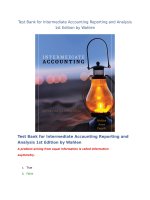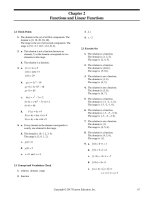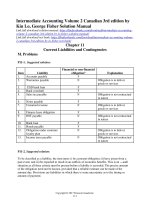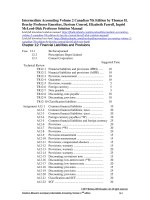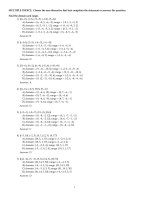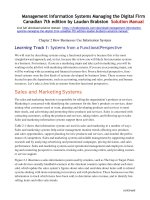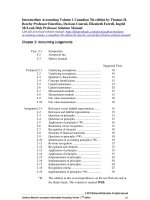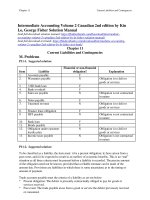Intermediate accounting volume 2 canadian 7th edition by beechy conrod farrell dick solution manual
Bạn đang xem bản rút gọn của tài liệu. Xem và tải ngay bản đầy đủ của tài liệu tại đây (3.11 MB, 530 trang )
Intermediate Accounting Volume 2 Canadian 7th Edition by Thomas H.
Beechy Professor Emeritus, Davison Conrod, Elizabeth Farrell, Ingrid
McLeod-Dick Professor Solution Manual
Link full download solution manual: />Link full download test bank: />
Chapter 12: Financial Liabilities and Provisions
Case 12-1
12-2
12-3
Ski Incorporated
Prescriptions Depot Limited
Camani Corporation
Suggested Time
Technical Review
TR12-1
TR12-2
TR12-3
TR12-4
TR12-5
TR12-6
TR12-7
TR12-8
TR12-9
TR12-10
Financial liabilities and provisions (IFRS) ......
Financial liabilities and provisions (ASPE) .....
Provision, measurement ...................................
Guarantee .........................................................
Provision, warranty ..........................................
Foreign currency ..............................................
Note payable ....................................................
Discounting, note payable ................................
Discounting, provision .....................................
Classification liabilities ....................................
Assignment A12-1
A12-2
A12-3
A12-4
A12-5
A12-6
A12-7
A12-8
A12-9
A12-10
A12-11
A12-12
A12-13
A12-14
A12-15
A12-16
A12-17
A12-18
A12-19
A12-20
A12-21
A12-22
Common financial liabilities ............................
Common financial liabilities: taxes .................
Common financial liabilities: taxes ................
Foreign currency payables (*W) ......................
Common financial liabilities and foreign currency
Provisions .........................................................
Provisions (*W) ...............................................
Provisions .........................................................
Provision measurement ....................................
Provision measurement ....................................
Provisions; compensated absences ..................
Provisions; warranty ........................................
Provisions; warranty .......................................
Provisions; warranty .......................................
Discounting; no-interest note ...........................
Discounting; low-interest note (*W) ...............
Discounting; low-interest note .........................
Discounting; provision .....................................
Discounting; provision .....................................
Discounting; provision .....................................
Classification and SCF .....................................
SCF ..................................................................
10
10
10
10
5
5
5
10
10
10
10
20
20
10
25
20
20
20
15
15
15
15
20
25
15
20
20
15
25
25
20
20
© 2017 McGraw-Hill Education Ltd. All rights reserved.
Solutions Manual to accompany Intermediate Accounting, Volume 2, 7th edition
12-1
A12-23 Liabilities - ASPE ................................................................ 10
A12-24 Liabilities - ASPE (*W) ..................................................... 20
A12-25 Liabilities - ASPE ................................................................ 20
*W
The solution to this assignment is on the text website, Connect.
The solution is marked WEB.
© 2017 McGraw-Hill Education Ltd. All rights reserved.
12-2
Solutions Manual to accompany Intermediate Accounting, Volume 2, 7th edition
Cases
Case 12-1
Ski Incorporated
To: Members of Board of Directors
From: Accounting Advisor
Overview
Ski Incorporated (SI) is a public company therefore you are using IFRS. The bank loan
has a minimum current ratio so you will need to be careful and watch for any impacts on
the ratio. You have had a tough year this year with a taxable loss so the bank financing is
critical to your operations. Management will be concerned with their bonus based on net
income but this will not be a concern this year with the taxable loss since there will not be
any bonus.
Issues
1.
2.
3.
4.
5.
6.
7.
8.
9.
Taxable loss
Revenue recognition memberships
Revenue recognition guests
Special promotions
Coupons
Dealer Loan
Lawsuit
Lease
Gasoline storage tanks
Analysis and Recommendations
1. Taxable loss
SI had a taxable loss of $400,000 in 20X5. Since this is the first ever taxable loss the loss
would be carried back for up to three years to recover past taxes paid at the tax rates in
those years. Usually you would want to go back three years first so that if you incur
another loss next year you can still go back to the other two years if there is taxable
income remaining. This will result in an income tax receivable which will increase
current assets and have a positive impact on your current ratio.
2. Revenue recognition memberships
© 2017 McGraw-Hill Education Ltd. All rights reserved.
Solutions Manual to accompany Intermediate Accounting, Volume 2, 7th edition
12-3
The contract with the customer is for the membership in the club. This would be a written
agreement between the member and SI. There is one performance obligation, the
promised service is membership in the ski club. There is no transfer of the service until
the membership is provided. The contract price is $10,000. The non-refundable deposit is
an advance payment towards this initiation fee and is part of the overall transaction price.
The performance obligation for the initiation fee is satisfied over the period of time that
the member belongs to the club. The $10,000 would be recognized over the average
period a member belongs. There should be enough historical data available to come up
with a reasonable estimate. There would be no cash collection risk since the amount is
paid upfront.
The annual fee is a written agreement between the member and SI. There is again one
performance obligation the service for this year. The fee of $2,000 is the total contract
price and is received in 20X5 for the 20X6 ski season. This would be unearned revenue
when received. Assuming the ski season goes from Dec 1 until March 31 $500 would be
recognized in 20X5 and the remainder in 20X6 which would be the period in which the
service is performed. There would be no cash collection risk since the amount is paid
upfront.
3. Revenue recognition guests
The contract with the guest is the written contract when they receive the ticket to ski not
when the reservation is made since this reservation could be cancelled. The performance
obligation is the right to ski that day. The overall contract price is the price of the ski
ticket. The performance would be the right to ski on that day. There is no cash collection
risk since the guest pays by credit card when they purchase the ticket.
4. Special promotions
The contract with the customer is the written contract when they receive the ticket and
the right to a future lesson. There are two separate performance obligations the right to
ski and the right to the lesson. The total contract price is $100. This price would need to
be allocated to the two separate performance obligations based on their relative fair value.
Fair value ski pass
Fair value lesson
Total fair value
80 = 61.5% x 100 = $61.50
50 = 38.5% x 100 = $38.50
130
The $61.50 for the ski pass the performance obligation would be satisfied on the day that
they ski. For the $38.50 the performance obligation would be satisfied on the day they
take the lesson. There would be no cash collection risk assuming a credit card is used to
purchase the special pass.
5. Coupons
© 2017 McGraw-Hill Education Ltd. All rights reserved.
12-4
Solutions Manual to accompany Intermediate Accounting, Volume 2, 7th edition
It must be determined if an economic loss would occur for the coupons. The coupons are
for $5 and the price of a ski pass is $80. This is a minor amount compared to the price of
the ski pass so SI would still be selling the ski pass at a profit. Therefore, the coupons
should only be recognized as a cost when they are redeemed.
6. Dealer Loan
The manufacturer of the ski lift has provided a 0% interest loan. This is often referred to
as a dealer loan. The loan is either measured in FVTPL or other liabilities. Most liabilities
are measured in other liabilities and since there is no mismatch I recommend this loan be
recorded in other liabilities. SI is required to record the loan at fair value using the market
rate of interest which would be their incremental borrowing rate of 8%. Therefore, the
loan would be recorded at $2.5 million (2 periods, 8%) = $2,143,350. The loan would
then be amortized using the effective interest method and interest expense of $171,468
would be recorded in 20X5. This would not impact the current ratio in 20X5 because the
full amount would be presented as long term.
7. Lawsuit
It must be determined if the lawsuit is probable and if the amount can be measured. The
Board has decided to settle the lawsuit therefore it is probable there will be a payment.
The amount will be based on managements best estimate. Since there is a range this
would be the midpoint of the range or $250,000 should be accrued as a provision. In
addition, there would be note disclosure on the details of the lawsuit. This liability would
be current if the payment is made next year which would have a negative impact on the
current ratio.
8. Lease
The lease would be an onerous contract since the costs exceed the benefits since the
leased property will not be used by SI. A provision should be set up for the $10,000 –
5,000 = $5,000 x 24 months = $120,000. The current portion of the provision would have
a negative impact on the current ratio.
9. Gasoline storage tanks
The gasoline storage tanks would be set up as an item of property, plant and equipment
and depreciated over the 15 years. The costs to remove the tanks would be a legal
obligation and would need to be set up as a decommissioning provision. The provision
would be set up at the present value of the $2.5 million. The PV would be $2.5 million
(15 periods, 8%) = $788,100. This amount would be debited to the gasoline storage tanks
and credited to the provision. Since the life of the storage tanks and the decommission
provision are the same the $10,788,100 would be depreciated over the 15 years which
would be $719,207 of depreciation expense in 20X5. Interest expense of $63,048 would
© 2017 McGraw-Hill Education Ltd. All rights reserved.
Solutions Manual to accompany Intermediate Accounting, Volume 2, 7th edition
12-5
also be recognized in 20X5 which would increase the decommissioning provision. The
asset would be a long term asset and the decommissioning provisions would be a long
term liability so this would not impact the current ratio.
© 2017 McGraw-Hill Education Ltd. All rights reserved.
12-6
Solutions Manual to accompany Intermediate Accounting, Volume 2, 7th edition
Case 12-2
Prescriptions Depot Limited
Overview
Prescriptions Depot Limited (PDL) is a large private company with revenues of $5.4
billion and earnings of $295 million. The company complies with IFRS, and is
contemplating a public offering in the medium term. GAAP compliance is therefore
important. Reporting objectives are to report growth in sales, especially year-over-year
same-store sales growth, and stable earnings. Because of possible analyst interest, sales
measurement is of critical importance. Ethical reporting choices are critical, given the
possibility for increased scrutiny in the future; sudden changes in accounting policy at a
later date may not be viewed with favor by analysts. Reporting objectives are meant to
support a public offering.
Issues
1.
2.
3.
4.
Loyalty points program
Decommissioning obligations
Cash refund program
Coupon program
Analysis and recommendations
1. Loyalty points program
PDL operates a loyalty points program, which will impact on the measurement of
sales revenue, important for analysts.
Currently, a sale transaction with point value attached is recognized as a sale entirely
in the current period. An expense and liability for the cost – not sales value – of goods
to be redeemed in the future is recognized in the same time period as the sale.
This policy maximizes the sales value recorded with the initial transaction. It does not
reflect the substance of the transaction, though, which is that PDL has rendered
multiple deliverables in sale: both the initial sale, and the subsequent sale based on
points value are being sold.
Accordingly, PDL must consider an alternate approach to its loyalty point program:
1. The sale in the store is a contract with the customer but there are two separate
performance obligations. There is the sale of the goods now and the future
redemption of points. This loyalty program provides the customer with a
material right. On a sale that involves issuance of points, the consideration
© 2017 McGraw-Hill Education Ltd. All rights reserved.
Solutions Manual to accompany Intermediate Accounting, Volume 2, 7th edition
12-7
received must be allocated between the sale of the product and the points on a
relative stand alone basis. The value of points to be redeemed in the future is
recorded as unearned revenue.
2. As is now the case, careful measurement of the amount - unearned revenue,
now - includes analysis of redemption, bonus offers, breakage, expiry, and
the like.
3. When points are redeemed, the sales value of the redemption transaction is
recorded as sales revenue and cost of goods sold reflects the merchandise
purchased.
This approach defers sales revenue and gross profit to later periods.
As a result, current earnings (and sales) are lower, but future periods show higher
sales and earnings. Trends may be affected. Analysts will react better to accurate
information, and there is time for this to be assessed since plans to offer shares to
the public are described as ―medium term‖.
2. Decommissioning obligation
PDL has an obligation to remove its customized, specialized pharmacy installations in
leased premises. This is a future obligation based on a past action, and represents a
provision in the financial statements. It is not now recorded. This is essentially a
decommissioning obligation, and standards require recognition.
Accordingly, PDL must estimate the cost to restore premises, removing the custom
set-up. PDL must also estimate when restoration is likely to happen; lease renewal
must be assessed. Finally, a borrowing rate for the appropriate term and amount must
be estimated, and a discounted liability calculated.
The discounted liability is recognized as an asset and a liability. The asset is
depreciated over the life of the leased premises. Interest is accrued annually on the
liability. These two charges will decrease earnings, but represent appropriate
accounting measurement.
Note also that estimates must be revised, and any changes in estimate are reflected in
a revised present value and asset balance.
3. Cash refund program
The cash refund program is now accounted for when the refund takes place, recording
a reduction to cash and a reduction to sales.
Since the promotion involves a cash refund, an obligation exists to pay cash in the
future, based on a past transaction.
© 2017 McGraw-Hill Education Ltd. All rights reserved.
12-8
Solutions Manual to accompany Intermediate Accounting, Volume 2, 7th edition
If there was a refund period open over the end of a reporting period, this accounting
policy would not capture the obligation to provide refunds. That is, if the six week
documentation window were open, after a given promotion, there would be refunds to
be made based on recorded sales of the period. This obligation to provide refunds
would not be reflected in the financial statements.
Therefore, PDL must estimate the extent of cash refunds waiting to be filed and
record them as a liability when the promotion weekend ends. Estimates can be based
on past practice.
The amount refunded to customers should be reported as a sales discount (a contrasales account), not as a direct decrease to sales. It should also not be recorded as a
promotion expense, as it is a reduction in sales value. Recording the amounts as a
sales discount is preferable to directly reducing sales, because it may help preserve
information about the extent of program use for internal tracking. Analyses of sales
trends may focus on net sales, so this accounting treatment may not improve sales
trends, a corporate reporting objective.
The policy will record refunds earlier, and may decrease earnings in the short term.
Over time, there will be no cumulative difference to earnings.
4. Coupon program
The coupon program is now accounted for by recording sales at the amount of cash
received from customers. PDL then reduces inventory – and thus cost of goods sold for manufacturer rebates given for coupons redeemed. (i.e., debit accounts payable,
and credit inventory which becomes cost of goods sold). This has the correct impact
on gross profit (give or take some timing issues of inventory sale), but understates
sales.
Since PDL is increasingly concerned with correct measurement of sales, the
accounting policy for coupons must be revisited. The correct treatment:
1. Sales is measured at the retail price, regardless of whether the value is received
from customers ($20,000, in the case example) or from the manufacturer in the
form of coupons ($5,000). The coupons are in essence an account receivable, used
to reduce an account payable.
2. Merchandise is recorded at the invoice cost ($98,000) not the amount of cash paid
($93,000).
Using the existing accounting policy, sales are recorded at $20,000, and cost of goods
sold (for many products, one assumes) at $93,000. With the revised system, sales are
$25,000 and cost of goods sold is $98,000.
© 2017 McGraw-Hill Education Ltd. All rights reserved.
Solutions Manual to accompany Intermediate Accounting, Volume 2, 7th edition
12-9
There is no overall change to earnings, but sales are more accurately stated, which is
preferable for PDL.
Conclusion
Any company with an eye on public markets must carefully assess its reporting
practices and ensure appropriate accounting is followed. PDL has several policies,
for loyalty points, cash refunds and coupon transactions that impact on reporting
of sales and timing of earnings. In addition, they have unrecorded
decommissioning obligations. Appropriate accounting demonstrates the ethical
commitment of management.
© 2017 McGraw-Hill Education Ltd. All rights reserved.
12-10
Solutions Manual to accompany Intermediate Accounting, Volume 2, 7th edition
Case 12-3
Camani Corporation
Overview
Camani Corporation has been negatively affected by economic conditions, and the 20X3
financial results are under particular scrutiny to determine the viability of the existing
strategic model. The executive team will receive a ―return to profitability‖ bonus if 20X3
earnings are positive. Under these circumstances, there is obvious pressure to shade
reporting policies and estimates to support higher earnings. There are significant ethical
pressures on all stakeholders in the company, but especially management.
Issues
1.
Calculate cash from operating activities, based on current draft
financial statements.
2. Analyse reporting implications of identified estimated financial
statements elements: legal issues, depreciation policy, technology contract,
inventory valuation, restructuring and environmental liability.
3. Re-calculate cash from operating activities, based on revised financial statements
Analysis and conclusions
1. Cash flow from operating activities, existing draft financial statements
Exhibit 1 shows that cash flow from operating activities is a negative, at ($1,721).
Earnings of $1,535 reflect cash flows of ($800), and dividends on common shares
are another ($921). The negative operating cash flows are caused by large build-ups
in account receivable and inventory. The increase in accounts payable and accrued
liabilities works to mitigate this, but is not as large as the inventory build-up.
This is contrary to a return to profitability implied by positive earnings, and calls into
question the declaration of common dividends.
2. Analysis of accounting policies and estimates
a. Legal issues
The accrual has been made based on one set of expected values, resulting in the
accrual of $830. If a different, less optimistic set of probabilities is used, the accrual
is $1,110:
© 2017 McGraw-Hill Education Ltd. All rights reserved.
Solutions Manual to accompany Intermediate Accounting, Volume 2, 7th edition
12-11
Total payment
(in 000’s)
Alternate
probability
$ 100
500
700
1,200
2,200
0%
20
30
30
20
Expected
value
(000’s)
0
$ 100
210
360
440
$ 1,110
This is an additional liability and expense of $280 (See Exhibit 2).
b. Depreciation policy
Retaining prior years’ estimates for depreciation amounts would result in $200
additional depreciation. (See Exhibit 2).
c. Technology services
CC had recorded $1,200 as an estimate for technology services rendered; if the
$4,000 contract is considered 45% complete (rather than 30%), another $600 (15%)
must be recorded. This is a liability and presumably an expense. (See Exhibit 2).
d. Inventory valuation
Retaining prior years’ estimates for inventory valuation would result in $775
additional write-down ($3,125 - $2,350.) Note that inventory levels are higher in
20X3, which is not consistent with less need for a valuation adjustment. Much might
depend on the state of the economy, though, and a thorough review of the analysis the
CC has prepared. (See Exhibit 2).
e. Restructuring
No accrual has yet been recorded for a restructuring. The plan has not been
announced or approved, and the plan is not formal the plan at this stage. Only a
formal plan, once communicated, would meet the requirements of a constructive
liability. At this stage, recording is premature, and no accrual has been recorded.
f. Environmental liability
If the liability had been recorded at 5%, rather than 7%, $329 ($400, 4 years, 5%)
would have been recorded, rather than $306. Interest would have been $16, not $21
(a $5 difference), and depreciation, over four years, would have been $82, rather than
$77 (a $5 difference). These adjustments are minor, and are summarized in Exhibit 2.
© 2017 McGraw-Hill Education Ltd. All rights reserved.
12-12
Solutions Manual to accompany Intermediate Accounting, Volume 2, 7th edition
Effect on financial performance
The adjustments indicated by these areas have been included in the revised draft
statement of financial position and financial performance shown in Exhibit 3. The
statement of earnings now reflects a loss of $320. This would eliminate any return to
profitability bonus, and means that the operating strategy of the company needs to be
assessed.
3. Cash flow from operating activities, revised draft financial statements
The reported loss of $320 is more consistent with the negative cash flow from
operating activities. Exhibit 4 shows the revised operating activities section of the
SCF. Cash used by operating activities is unchanged, at ($1,721). This demonstrates
the reason that many focus on the SCF, since it is unaffected by estimates that
underlie earnings measurement.
Conclusion
Additional information should be requested by the audit committee in each these
areas, to gather evidence to support the accrual that has been made, or suggest a more
appropriate amount. Since profits are marginal and there is significant incentive for
management to show profit in 20X3, very careful evaluation of these areas is
warranted.
© 2017 McGraw-Hill Education Ltd. All rights reserved.
Solutions Manual to accompany Intermediate Accounting, Volume 2, 7th edition
12-13
Exhibit 1
Operating activities, SCF
Existing draft summarized financial statements
Camani Corporation
Operating Activities Section of the Statement of Cash Flow
Year ended 31 December 20x3
Operating Activities:
Net income ..........................................................................
$1,535
Adjustments for non-cash items:
Depreciation .......................................................................
3,900
Interest ...............................................................................
21
5,456
Changes in current assets and current liabilities:
Increase in accounts receivable ..........................................
(3,740)
Increase in inventory ..........................................................
(6,950)
Increase in prepaids ...........................................................
(87)
Increase in accounts payable and accrued liabilities ..........
4,521
Cash paid for common dividends ($1,535 + $643 = $2,178- $1,257)
....................................Netcashprovided(used)byoperations
(800)
(921)
$(1,721)
Exhibit 2
Camani Corporation
Adjustments based on estimated amounts
1) Expense ($1,110 - $830) ................................................................
Accrued liabilities ..................................................................
280
2)
Depreciation Expense ($4,100 - $3,900) .......................................
Plant and equipment (net) ......................................................
200
Expense .........................................................................................
Accrued liabilities ..................................................................
600
Expense ($3,125 - $2,350) ............................................................
Inventory ................................................................................
775
3)
4)
5)
None
6)
Depreciation expense ($82 - $77) ..................................................
Asset ($329-$306) less $5 extra depreciation ................................
Interest expense ($21 - $16) ...................................................
Accrued liabilities ($329 - $306) less $5 change in interest
280
200
600
775
5
18
5
..18
© 2017 McGraw-Hill Education Ltd. All rights reserved.
12-14
Solutions Manual to accompany Intermediate Accounting, Volume 2, 7th edition
Exhibit 3
Camani Corporation
REVISED Summarized Draft 20X3 Financial Statements
REVISED Summarized Draft Statement of Financial Position
At 31 December (in 000’s)
Assets
Cash
Accounts receivable
Inventory (-$775)
Prepaids
Land
Plant and equipment (net) (-$200 +$18)
Other assets
Total debits
Liabilities
Accounts payable and accrued liabilities(+$280 + $600)
Long-term debt (+$18)
Equity
Common shares
Retained earnings ($643 -$320 loss - $921 divs)
Total credits
20X3
20X2
$ 2,340
16,780
61,145
542
5,860
19,538
650
$106,855
$ 1,680
13,040
54,970
455
5,860
18,650
290
$94,945
48,268
53,545
42,867
46,200
5,640
(598)
$ 106,855
5,235
643
$ 94,945
REVISED Summarized Draft Statement of Earnings
For the year ended 31 December 20X3
Sales revenue
Cost of goods sold (+$775)
Depreciation expense (+$200 + $5)
Operating, administration and marketing (+$280 + $600 - $5)
Earnings and comprehensive income
$104,910
(67,005)
(4,105)
(34,120)
$ (320)
© 2017 McGraw-Hill Education Ltd. All rights reserved.
Solutions Manual to accompany Intermediate Accounting, Volume 2, 7th edition
12-15
Exhibit 4
REVISED Operating activities, SCF
Revised draft summarized financial statements
Camani Corporation
Operating Activities Section of the Statement of Cash Flow
Year ended 31 December 20x3
Operating Activities:
Net income (loss) ................................................................
Adjustments for non-cash items:
Depreciation .......................................................................
Interest ...............................................................................
Changes in current assets and current liabilities:
Increase in accounts receivable ..........................................
Increase in inventory ..........................................................
Increase in prepaids ...........................................................
Increase in accounts payable and accrued liabilities ..........
( $320)
4,105
16
3,801
(3,740)
(6,175)
(87)
5,401
(800)
Cash paid for common dividends (unchanged) .........................
....................................Netcashprovided(used)byoperations
(921)
$(1,721)
© 2017 McGraw-Hill Education Ltd. All rights reserved.
12-16
Solutions Manual to accompany Intermediate Accounting, Volume 2, 7th edition
Technical Review
Technical Review 12-1
1. T
2. F – The effective interest method is required in IFRS.
3. F – The gain or loss is recognized in earnings.
4. T – if each point in the range is equally likely
5. F – the refinancing must be completed by the year-end date for the mortgage to be
classified as long term
Technical Review 12-2
1. F – only legal obligations are included not constructive obligations
2. T
3. T
4. F – if each point in the range is equally likely the lower end of the range not the
midpoint would be used
5. T
© 2017 McGraw-Hill Education Ltd. All rights reserved.
Solutions Manual to accompany Intermediate Accounting, Volume 2, 7th edition
12-17
Technical Review 12-3
Case
1.
2.
3.
Most likely outcome
Most likely outcome is 0, p
= 70%
Likely (90%)
The most likely payout is
$200,000
Likely (90%)
The most likely payout is
$100,000
Expected value
Expected value is
($100,000 x 10%) +
($200,000 x 10%)+
($300,000 x 5%)+
($400,000 x 5%) =
$65,000.
(Still less than one
payout)
Expected value is
($100,000 x 10%) +
($200,000 x 60%)+
($300,000 x 5%)+
($400,000 x 15%) =
$205,000.
(Very close to most
likely outcome)
Expected value is
($100,000 x 30%) +
($200,000 x 20%)+
($300,000 x 20%)+
($400,000 x 20%) =
$210,000.
(NOT close to most
likely outcome)
To record
No accrual based
on most likely
outcome
Accrual of
$200,000, most
likely outcome
Accrual of
$210,000
60% chance that
payout is higher
than $100,000 so
accrual of most
likely outcome is
not adequate.
Technical Review 12-4
A guarantee is measured at its fair value. It would be measured at $300,000 x 30% =
$90,000.
© 2017 McGraw-Hill Education Ltd. All rights reserved.
12-18
Solutions Manual to accompany Intermediate Accounting, Volume 2, 7th edition
Technical Review 12-5
Requirement 1
Warranty expense in April, $24,750 ($550,000 × 4.5%)
Requirement 2
Balance in the warranty provision account at the end of April is
$18,450 ($16,400 + $24,750 – $8,700 – $14,000)
Technical Review 12-6
1) The Canadian equivalent of the payable when it is first recorded is US $150,000 x Cdn
@ .75 = $112,500. The inventory would be valued at $112,500.
2) The amount in the exchange gain or loss account at the end of the year would be year
end US $150,000 x Cdn @ .72 = $108,000. Therefore, the difference of $112,500 –
108,000 = 4,500 would be in the exchange gain or loss account. The $4,500 represents a
foreign exchange gain (credit to the account).
Technical Review 12-7
1 October 20x6
Cash ............................................................................................... 120,000
Note payable ..........................................................................
120,000
31 December 20x6
Interest expense ($120,000 x 9% x 3/12) ......................................
2,700
Interest payable .................................................................
2,700
30 September 20x7
Interest expense ($120,000 x 9% x 9/12) .....................................
8,100
Interest payable ..............................................................................
2,700
Cash (120,000 x 9%).........................................................
10,800
31 December 20x7
Interest expense ($120,000 x 9% x 3/12) ......................................
2,700
Interest payable .................................................................
2,700
30 September 20x8
Interest expense ($120,000 x 9% x 9/12) .....................................
8,100
Interest payable ..............................................................................
2,700
Cash (120,000 x 9%).........................................................
10,800
Note payable .................................................................................. 120,000
Cash .......................................................................................
120,000
© 2017 McGraw-Hill Education Ltd. All rights reserved.
Solutions Manual to accompany Intermediate Accounting, Volume 2, 7th edition
12-19
Technical Review 12-8
Requirement 1
Principal $250,000 (P/F, 7%, 2) = $250,000 × (0.87344) ......................................
Interest $5,000 (P/A, 7%, 2) = $5,000 × (1.80802) ................................................
$218,360
9,040
$227,400
Requirement 2
(1)
Opening
Net
Liability
(2)
Interest
Expense 7%
(3)
Interest Paid
(4)
Discount
Amortization
(2) – (3)
Market Rate
(5)
Closing
Net
Liability
(1) + (4)
$227,400
$15,918
238,318
16,682
$5,000
5,000
$10,918
$238,318
11,682
250,000
© 2017 McGraw-Hill Education Ltd. All rights reserved.
12-20
Solutions Manual to accompany Intermediate Accounting, Volume 2, 7th edition
Technical Review 12-9
Requirement 1
Present value $420,000 (P/F, 6%, 10) = $420,000 × (0.55839) ............................. $234,524
Requirement 2
(1)
Opening
Net
Liability
(2)
Interest
Expense @
Market Rate
(3)
Closing Net
Liability
(1) + (2)
(1) × 6%
$234,524
$14,071
$248,595
248,595
14,916
263,511
263,511
15,811
279,322
(three years only)
Requirement 3
Revised present value $490,000 (P/F, 8%, 7) = $490,000 × (0.58349) .................. $285,910
Interest expense, 20X8 (line 3 of table above) ........................................................ $ 15,811
Adjustment to asset and obligation ($285,910 less $279,322 (Table, above)) ....... $ 6,588
Technical Review 12-10
1. Current
2. Current
3. Current
4. Non-current
5. Current
© 2017 McGraw-Hill Education Ltd. All rights reserved.
Solutions Manual to accompany Intermediate Accounting, Volume 2, 7th edition
12-21
Assignments
Assignment 12-1
Requirement 1
a. Office supplies inventory ..........................................................
Accounts payable ...................................................................
5,200
b. Cash...........................................................................................
Note payable .........................................................................
30,000
c. Inventory ..................................................................................
Accounts payable .....................................................................
143,000
d. Utilities expense ........................................................................
Accounts payable ....................................................................
2,600
e. Dividends, preferred (or retained earnings) ..............................
Dividends, common (or retained earnings) ...............................
Dividends payable .................................................................
6,000
5,000
f. Accounts payable ......................................................................
Inventory ..................................................................................
35,200
g. Accounts payable ......................................................................
Cash ($143,000 - $35,200) x 50% ...........................................
53,900
h. Interest expense ($30,000 x 10 % x 1/12) .................................
Interest payable ........................................................................
250
5,200
30,000
143,000
2,600
11,000
35,200
53,900
250
i. Rent expense .............................................................................
2,400
Accounts payable ..................................................................
2,400
Note: Students may record utilities and rent is separate payable accounts, or in
accounts payable. Both are acceptable.
Requirement 2
Accounts payable
Note payable
Interest payable
Dividends payable
64,100 cr.
30,000 cr.
250 cr.
11,000 cr.
(1)
(1)
(1) See note above; utilities and rent may be in separate payables accounts. Similarly,
dividends payable may be two accounts, one for common and one for preferred.
© 2017 McGraw-Hill Education Ltd. All rights reserved.
12-22
Solutions Manual to accompany Intermediate Accounting, Volume 2, 7th edition
Assignment 12-2
a. Cash ......................................................................... 3,780,000
Sales revenue .........................................................................
GST payable ($3,600,000 x 5%) ...........................................
b. Cash .........................................................................................
Sales revenue .........................................................................
GST payable ($12,400,000 x 5%) .........................................
3,600,000
180,000
13,020,000
12,400,000
620,000
c. Equipment .................................................................................
GST payable ($1,250,000 x 5%) ................................................
Cash .......................................................................................
1,250,000
62,500
d. Salaries expense ........................................................................
Employee income tax payable ...............................................
EI payable ..............................................................................
CPP payable ...........................................................................
Cash .......................................................................................
85,800
e. Cash .........................................................................................
Sales revenue .........................................................................
GST payable ($2,800,000 x 5%) ...........................................
2,940,000
f. Inventory (or purchases) .........................................................
GST payable ($12,200,000 x 5%) ..............................................
Cash .......................................................................................
12,200,000
610,000
1,312,500
7,400
1,400
1,200
75,800
2,800,000
140,000
12,810,000
g. Salaries expense ........................................................................
Employee income tax payable ...............................................
EI payable ..............................................................................
CPP payable ...........................................................................
Cash .......................................................................................
85,800
h. Salary expense ...........................................................................
CPP payable ($1,200 x 2) ......................................................
EI payable ($1,400 x 2 x 1.4).................................................
6,320
i. Employee income tax payable ...................................................
EI payable ($1,400 x 2) + $3,920 ...............................................
CPP payable ...............................................................................
Cash .......................................................................................
14,800
6,720
4,800
7,400
1,400
1,200
75,800
2,400
3,920
26,320
© 2017 McGraw-Hill Education Ltd. All rights reserved.
Solutions Manual to accompany Intermediate Accounting, Volume 2, 7th edition
12-23
j. GST payable ............................................................................... 267,500
Cash .......................................................................................
267,500
Balance: ($180,000 + $620,000 + $140,000) – ($62,500 + $610,000) = $267,500
Assignment 12-3
Liabilities:
GST payable (1) .................................................................................. $122,000
Income tax deductions payable (2) ..................................................... 47,400
CPP payable (3) .................................................................................. 13,500
EI payable (4) ......................................................................................
13,280
(1)
(2)
(3)
(4)
$43,000 + $708,000 – ($1,920,000 x 5%) – $533,000 = $122,000
$2,600 + $21,400 + $23,400 = $47,400
$1,900 + $2,800 + $3,000 + employer, $5,800= $13,500
$800 + $2,400 + $2,800 + employer, ($5,200 x 1.4) = $13,280
© 2017 McGraw-Hill Education Ltd. All rights reserved.
12-24
Solutions Manual to accompany Intermediate Accounting, Volume 2, 7th edition
Assignment 12-4 (WEB)
a)
b)
c)
d)
e)
f)
Inventory (70,000 x $2.11) .................................................... 147,700
Accounts payable ..............................................................
147,700
Inventory (150,000 x $1.11) .................................................. 166,500
Accounts payable ..............................................................
166,500
Inventory (20,000 x $2.13) ....................................................
Accounts payable ..............................................................
42,600
42,600
Accounts payable ................................................................... 166,500
Foreign exchange loss ............................................................
9,000
Cash (150,000 x $1.17) .....................................................
Accounts payable ...................................................................
Foreign exchange loss ............................................................
Cash (20,000 x $2.20) .......................................................
175,500
42,600
1,400
Accounts payable ................................................................... 147,700
Foreign exchange loss ............................................................
4,200
Cash (70,000 x $2.17) .......................................................
44,000
151,900
© 2017 McGraw-Hill Education Ltd. All rights reserved.
Solutions Manual to accompany Intermediate Accounting, Volume 2, 7th edition
12-25
